North and Farwell
It’s already quite vibrant, but changes like turning Prospect and Farwell into two-way streets could improve it.
Shaped by former streetcar tracks, the intersection of E. North Avenue and N. Farwell Avenue is a vibrant hub of nightlife and shopping. Although the surrounding neighborhood is somewhat age-diverse, with a senior living center nearby and many owner-occupied single-family homes, this intersection is definitely geared towards a younger crowd of college students and twentysomething professionals.
It’s home to Milwaukee institutions like the Oriental Theatre, Landmark Lanes, Beans and Barley, and Von Trier (which, when I moved to Milwaukee, was recommended as the first bar I must try). Modern buildings like Whole Foods and the new Standard at East Library are steps away from the 1920‘s-era Oriental movie theater and Von Trier’s classic German-styled tavern. Overall, the intersection is a walkable, vibrant area dotted with bars, restaurants, grocery stores and other amenities that particularly appeal to the student population that lives nearby. Initiatives like the new library are a step in the right direction, but other efforts will be necessary to ensure that this vibrant, resilient street becomes more inviting to people of all demographics.
What Works
Many of the businesses that exist on this street today—like Beans and Barley and Von Trier—have been around for decades, so the intersection had a solid foundation. Its unique, rounded corners and multiple intersecting streets are caused in part, by its history as a streetcar line. The front of Von Trier, for example, was rounded out to allow an appropriate turning radius for streetcars long ago.
These distinctive features are preserved in the intersection’s current state, but with new businesses to keep it lively. The last few years have seen strong growth in the economic vitality and life on this street. Nearly every storefront is occupied now. As Ald. Nik Kovac (whose district this corner is in) tells me, “We’ve really raised the bar for architecture in that area.” Some government efforts that have made this possible include adjusting zoning codes, and raising the minimum and maximum heights allowed for buildings in the area. Today, the contrast of dazzling new structures and quirky, historic facades makes for an exciting intersection with plenty to see and do
This intersection’s greatest asset is its strong, successful, mostly locally- owned businesses. Walk down North Avenue at nearly any hour, day or night, and you will see parents heading into the grocery store with their kids, college students grabbing a bite to eat or using an ATM at one of the banks, and, in the summer time, happy bar-goers sitting at sidewalk cafes. The ambience is intoxicating.
What Doesn’t
There’s not much to criticize, but a few things could improve the intersection. First, the street can get overwhelmed with drunken college students and other young people at night and on weekends. During a week like St. Patrick’s Day, North and Farwell was practically unbearable. Of course, that meant a considerable amount of additional business for the bars and restaurants on the block, but it also meant neighbors and children who just wanted a book from the library were forced to endure swearing, vomiting and general debauchery as they walked down the sidewalk in broad daylight. I am writing this as a person who fits the age group that seemed to cause most of the trouble. A little civility would go a long way, but the structure of the street also encourages this behavior.
In the summertime, many restaurants and bars expand onto the sidewalk with tables and chairs for outside seating. This can create a pleasant, upbeat atmosphere, but it can also tend toward the drunken and obnoxious, especially as day turns to night. Maya Pisel, a young woman who lived near this intersection for more than a year says she often “felt uncomfortable walking literally an inch away from people’s lunch or happy hour carrying my groceries.” The intersection of North and Farwell, she notes, “almost always has a mix of people coming to drink and spend money, and people doing basic, life stuff like catch the bus or go to the bank or hospital. This mixing happens pretty respectfully during the day. But, coming home from work around 11:30pm was often jarring, especially on Thursdays and Fridays. People seem to treat that area as a place where it’s okay to have a lot to drink and act recklessly without concern for their impact on others… a lot of people running across that intersection against traffic, shouting, taking up more than their fair share of the sidewalk, driving recklessly and playing loud music.”
Pedestrian safety is also a concern here, despite the wide sidewalks and signals. As Kovac puts it, “It’s a corner where car is king.” It’s not just drunk partiers who are in danger because of their inebriated state. Children, the elderly and people in wheelchairs all pass though this intersection and they aren’t able to react quickly to a car suddenly turning right into them as they cross the street.
How Can We Improve It?
The East Branch library has already done an excellent job of drawing a more diverse demographic to this area. In particular, the decision to locate the entrance to the library on Murray Avenue instead of facing the parking lot in the back creates far more activity of different types on people on the sidewalk. The mix of businesses nearby also helps. From my own experience living near here, I value the ability to get some groceries and stop by the library (and maybe grab a mini donut) all in the same trip.
However, I’d like to see this business diversity increase further. Farwell and North could be an excellent location for clothing retail—especially retail that appeals more to the family-oriented, Whole Foods-shopping crowd as opposed to Urban Outfitters down the street. With the exception of the expensive retail in the Third Ward, there is a notable lack of clothing stores within the city limits of Milwaukee. Other forms of retail might also find success here. The resulting diversity would create a better balance between rambunctious young people and others who want to get their shopping done in peace—at least during the daylight hours.
Another change that could improve this intersection is a pedestrian-only segment in the traffic signal sequence wherein all the pedestrian walk signs would light up at once and all the cars would halt. The would ensure better safety and less confusion about when to cross. It might even help out the intoxicated kids trying to run across the street against traffic. (One can at least hope.) Kovac has faith that the increase in residential units on North Ave and nearby will also lead to better pedestrian safety. “The safest thing for pedestrians is more pedestrians,” he says. Kovac also notes a study is underway to explore the feasibility of transforming Farwell and Prospect into two-way streets, a change local businesses have advocated. This would slow traffic considerably and likely create more economic activity.
North and Farwell is a thriving, successful hub of attractive architecture and local businesses, many in operation for years. Building from that foundation to increase the diversity of businesses and upgrade the safety of pedestrians would serve to make the intersection more inviting for people young and old, allowing this East Side hub to prosper for decades to come.
E. North Ave. and N. Farwell Ave.
If you think stories like this are important, become a member of Urban Milwaukee and help support real, independent journalism. Plus you get some cool added benefits.
Intersection
-
The Port of Milwaukee Interchange Is an Overbuilt Mess
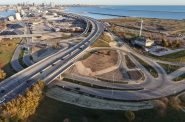 Nov 16th, 2025 by John O’Neill
Nov 16th, 2025 by John O’Neill
-
6 Changes Needed on Commerce & North
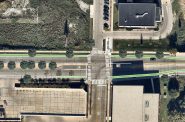 Aug 25th, 2017 by John O’Neill
Aug 25th, 2017 by John O’Neill
-
Farwell and Brady Need Changes
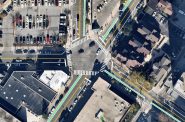 Mar 30th, 2017 by John O’Neill
Mar 30th, 2017 by John O’Neill


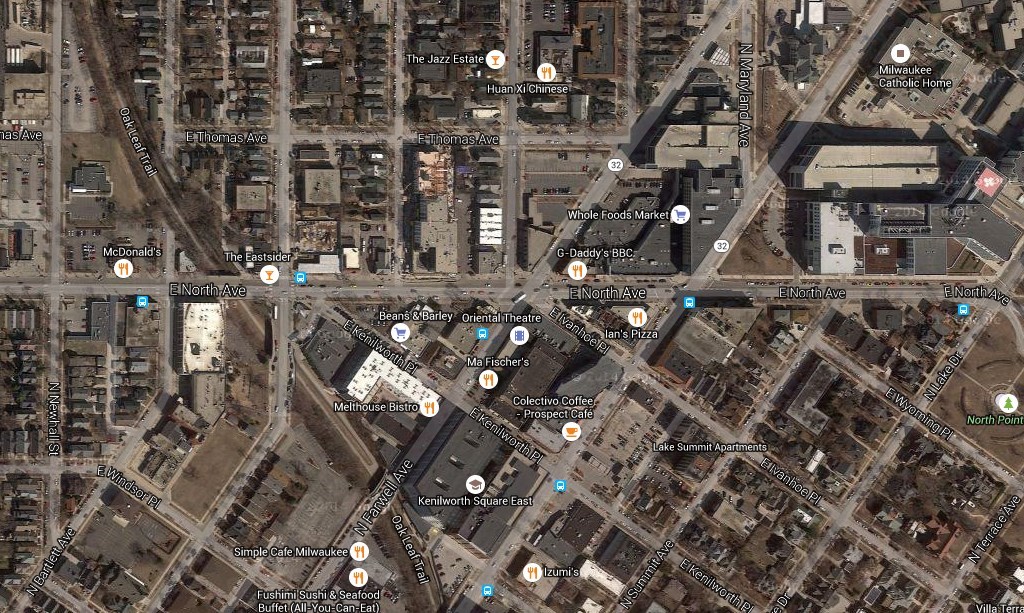
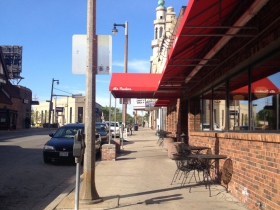
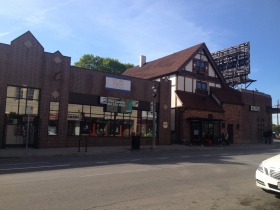
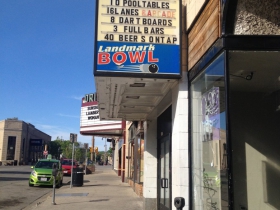
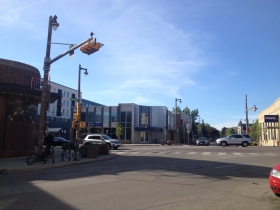
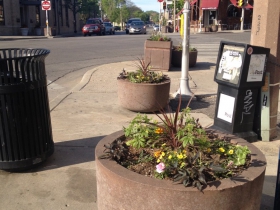
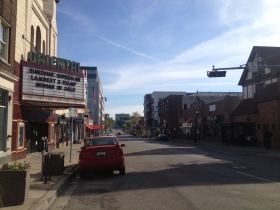



















I also live in the neighborhood and I find it uncomfortable walking around that area in the evenings as well. The litter is awful and smokers feel they have the right to flick their butts anywhere. There are thousands of cigarette butts all over the place and the bars really don’t bother sweeping up outside their establishments. For an area that has a lot going on, its strangely creepy. However, I do like the farmer’s market. I’m afraid most adults are just avoiding the neighborhood.
I don’t think the city will make Farewell or Prospect two way anytime soon because they plan on running the streetcar down those streets. I think a speed buffer would make sense. All speeds should not exceed 25mph within a certain zone…. and it needs to be enforced. Farwell, Prospect and North are freeways and one of every 20-30 cars actually stop at the crosswalk in front of Beans. Its not enforced. Each year a new crop of texting addicted 18 year olds from Two Rivers or wherever has to learn to watch out for pedestrians. There is a learning curve. It’s just a matter of time until someone is killed (again).
Hopefully the city will look at the entire Prospect/Farwell corridor from downtown north near UWM. This ought to be a corridor where transit service (whether bus or rail or both) has some sort of priority treatment, but given the city’s seeming unwillingness to take steps within its control to improve transit service I don’t have much confidence that this will happen.
The intersection (and others nearby) ought to be narrowed as much as possible to encourage drivers to slow, or better yet stop, when making turns and to shorten the distance pedestrians have to cross streets. Curb extensions (neck downs) ought to be standard practice at intersections and bus bulbs should be added along major bus routes. Essentially the design of the street should serve to enforce pedestrian priority.
The pedestrian only walk signal would be excellent for this intersection, even if it only occurs during certain evening hours on the weekend where there are tons of pedestrians moving from bar to bar, possibly intoxicated. They could add another diagonal crosswalk as well so that pedestrians could, for example, walk from the Von Trier corner to the G-Daddy’s corner.
I don’t see the traffic issue being solved however, or at the very least being solved in a manner that balances all parties. Farwell, Prospect, and North are all major thoroughfares where a lot of commuters travel in the morning and evenings. North Avenue, especially, can get laughably backed up after work as it’s the main access point to the area from I-43. Every time I’ve headed in that direction after work there are a lot of cars that utilize the parking/bike lanes to facilitate their travel down North because of the congestion. Efforts to further restrict vehicular movements aren’t likely to be met with open arms from those who use cars in the neighborhood. Same with those who travel from the upper east side south toward downtown.
What would be cool is if there was some sort of active system that could alter the configuration of the streets/intersections based on need. I can’t think of a solution that isn’t overly complicated/expensive but something that restricted vehicular traffic at night and on the weekends (in the process making the street more pedestrian friendly) but opened up during rush hour or special events like the fireworks.
When Farwell and Prospect were two way streets, it was a different eastside. First, there were many fewer cars. Parking on the street was a possibility. Second, at that time, you had the post office delivering virtually everything, and usually on foot. Now during the day you can have 3 or 4 post office trucks in a 3 block area. Add in two types of FEDEX trucks, UPS and various other delivery and moving companies you have a lot more vehicles stopping in traffic. Even without a street car, two way traffic would be bunged up many hours each day, unless all parking were prohibited. Can’t see that happening. Third, when the streets were two way, there were many more homes that maybe had maybe one car, now they have been replaced with apartment buildings and many of those were built before they were required to have sufficient parking for their residents. Also competing for space with the parkers are the underutilized bike lanes. It seems most of the bikes run on the sideWALKS, and seem to try to run down the 90 year old residents of the Jewish Home and St. John’s. Sorry runners and bicyclists, but the best place for a street car or higher speed buses is the bike path which used to be railroad right-of-way. Leave Prospect and Farwell one way.
Traffic and behavior in the North Avenue triangle area are just fine. It’s gradually become more densely populated, so a little more like a near downtown Chicago neighborhood than the hub of our lower east side has been over the past fifty years, but North Avenue east of the river is a near downtown neighborhood, so it’s not surprising that a variety of activities take place in a single area. (It’s not a suburb where residential and commercial / retail / entertainment areas are located somewhat more apart from each other.) The triangle has always been the center of one of the best neighborhoods in the City of Milwuakee because it’s got so much going on, and sometimes, so many people, together in one place. Full of life, rough edges and all. Folks want to live someplace it’s a little quieter, a little less raucus in the evening hours, there are plenty of options like that within short walking distance of the North Avenue triangle. Or further away for those offended by city life.
Thanks for the advice Neal. We live in the area because we do like it. That doesn’t mean it can’t be improved. The Eastside bid should be more proactive and property owners should be more accountable. That being said, if the city wants to make the area safer for pedestrians they should enforce the laws or don’t have them. Thanks for the lesson though.
I lived at 2345 N. Cramer for years, right across from the old East Library’s parking lot. I love and miss that area, though it’s changed a lot since then. Being so close to Blockbuster, the Oriental, Alterra, Beans & Barley, those were good times. I have never been much of a night owl and my only beef was how loud it got on weekends. Basically every Friday and Saturday night you were going to be kept up by loud drunks. That was annoying, but the amenities of that area far outweighed that annoyance.
For traffic, the biggest problem is improper lane usage. One commenter noted how parking lanes were used to keep traffic moving. Yes, we should encourage traffic moving at a neighborhood appropriate speed, but that doesn’t mean we should back up 25 cars so one can turn left (don’t forget there are 25 cars going the other way that prevent the turn). This doesn’t “slow” traffic, it stops it and causes more bad behavior. Control the left turns or provide space for them and define what the remaining spaces are supposed to be used for — like the bus stop lane at Oakland/North is not for cars continuing east on North to turn on Ivanhoe.
Having all the lights turn red sounds a lot like a pedestrian scramble (All lights red, and a pedestrian walk sign for a diagonal crossing). I used one in Chicago – it might be a good fit at that intersection.
http://articles.chicagotribune.com/2013-05-31/news/chi-loop-intersection-to-test-pedestrian-scramble-20130530_1_crash-related-pedestrian-injuries-klein-jackson-boulevard